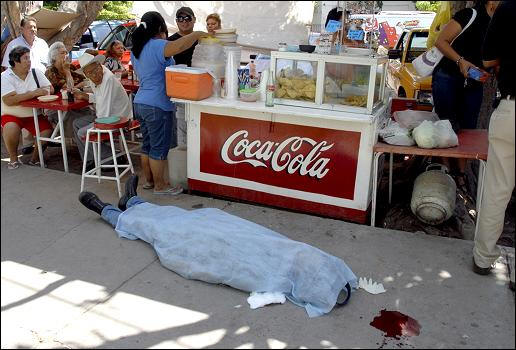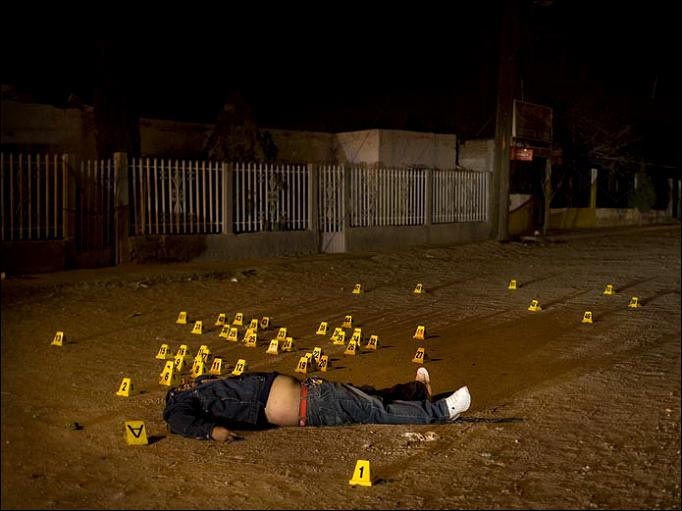
[See: It's like the Middle Ages… there's no purpose other than living another day ]

IT'S a Sunday picnic scene like nowhere else on earth.
Under a searing desert sun the headless body of a drug trafficker bleeds on to the pavement, staining it deep scarlet. Alongside his earthly remains local families unwrap sandwiches, drink iced tea and eat chilli hot-dogs under umbrellas, barely blinking at the absolute horror in their midst.
Remarkably the assassination, in the very heart of a bustling market town, barely breaks the flow of conversation and daily life.
Just another corpse on the most violent streets in the world. Most surprising of all, this astonishing scene is not playing out in the militant quarters of Kabul or Baghdad - but less than a mile from the American border.
On patrol with Mexican federal cops in these badlands - where dead bodies litter the streets like discarded cigarette ends and coffin makers work non-stop seven days a week - we uncover a terrifying story much closer to home than you think.

For, with the fall of Colombia's infamous drug cartels the cravings of Britain's one million cocaine users are met by Mexico's new generation of gangsters who have ruthlessly taken over the trafficking from South America to London, Manchester and Glasgow.
The US Drug Enforcement Agency says one in three lines of cocaine snorted in the UK, from council estate front rooms to private Mayfair clubs, has passed through the rising Mexican kingpins.
The medieval feud for control of the trade knows no boundaries. In the under-siege city of Ciudad Juarez even children, grandmothers, pregnant women, priests and paramedics have been gunned down in anger, all to ensure a line of cocaine in the world's richest capitals.
"Why in God's name are you crossing here?" says the American border official quietly as I hand over my passport to cross into Mexico's most deadly city. In my hand he presses the official US Travel Advisory note warning travellers to AVOID Juarez at all costs. It is now officially the world's most dangerous place to live.
Here drug murders reach a dozen a day and bullet-riddled vehicles and corpses in pools of blood are commonplace on busy streets. In 2010 a staggering 1,853 people have been slaughtered in the city so far. In January Juarez hit its lowest point when hitmen burst in on a party of high school students and killed 15, mostly kids under 16.

Within 30 minutes of entering Mexico my worst fears are confirmed. "There has been another shooting in Tierra Nueva," says my driver matter-of-factly mentioning a nearby suburb at the heart of the war. "It is on the radio." "Okay. Go!" I tell him. As we approach the crime scene where a crowd is gathered I see a body sprawled on the street.
Alongside is a smaller white sheet and I pray it isn't a child. Around the corpses, floating in dark pools of blood, tiny yellow plastic police triangles mark the spent casings of bullets pumped into the victims' truck. I count 72 then give up. The killers must have sprayed their targets with jolting automatic weapons to the point of exhaustion.
Bent over one body is the victim's mother. "Mi hijo! Mi hijo!" she screams - "My son! My son!" The crowd stares in silence. Nobody offers help, not even a hand of comfort.
Beyond the yellow police tape a ghostly quiet gives way to the whirring blades of an army helicopter. The rotors send the flimsy white body sheets flying. For the first time I see the face of one of the Juarez dead. He is a boy, no older than 16. On his bare torso I can see tattoos - indelible proof of loyalty to a drug gang.
Rodriguez, a local police officer, later takes me on patrol in the downtown area. Any further out and I will make him a target, he warns.

We drive through a city blighted with shuttered restaurants and shops. Rubbish and unopened mail gathers around the doorways of empty office buildings. The back of the dark blue police sedan stinks of fear and sweat.
Rodriguez tells me of drug-related slayings every day in houses, restaurants and bars, at playgrounds and children's parties, and car-to-car ambushes. Even outside school gates and chapels. The night I arrive local news reports carry details of a massacre at a pool party where children looked on as their parents were slaughtered.
"The killings here are medieval," says the officer. "We have bodies hung headless from bridges, stuffed upside down in giant cactus pots, lined up by a school playing field with their penises rammed in their mouths. Often, they are accompanied by messages written on walls in the victim's blood.
"My town makes the war on the Taliban look like a playground fight yet the world ignores it. We are suffering but all the focus is on Kabul."
Juarez cops believe this year's death toll will hit 3,300. With a tear in his eye Rodriguez tells me every day here is now Día de los Muertos - the Day of the Dead. "This might just be as close to hell on earth as you can get," he says. "Every night my wife begs me not to go on patrol. I look my children in the eye and I leave. We all know someone who has died. For me it might only be a matter of time."
The patrol car radio blares and I feel tense, heightened by the distinct sound of automatic gunfire close to the border. When we reach the scene Rodriguez clears a path through the crowd of onlookers. I don't even look at the body in front of me this time.

"That's ten today man!" says a boy, no older than 13, beside me.
Next to the corpse an officer stands noting the injuries, whispering them under his breath to a local news reporter: broken left tibia, stab wounds to the abdomen, knife punctures in torso, gunshot wounds, lashes to back, second degree burns to genitals. It's clear this victim was tortured.
By night's end another four will suffer the same fate. The Juarez drugs gangs are using increasingly indiscriminate horrific violence to intimidate rivals, security forces and innocents alike.
Most gruesome of all, the face of 36-year-old Hugo Hernandez, was found stitched on to a football and dumped outside a government building as a warning to the enemy.Nowhere in Juarez is the touch of death felt more than in the morgue. Last year, 2,300 victims of drug- related violence were wheeled in here.
In this pungent, formaldehyde-scented room doctors work to Mexican love ballads as the whir of electric saws cuts through bullet-shredded bone. Boxes stuffed with clients' bloodstained leather boots, mobile phones and home-made bulletproof vests are stacked to the ceiling.

Most of the dead are adorned with gang tattoos. "There is a lot of superstition here - some bodies have been tortured in voodoo ceremonies," said one forensic officer, who refused to be named for fear of reprisals. "What we do can put these people away so we are worried. We are targets like the police. This room, surrounded by their dead, has become our prison."
On the outskirts of Juarez the San Rafael cemetery stands out from the desert scrub as a crude burst of colour. Here, under the harsh glare of a full border sun, artificial flowers and ribbons adorn the graves.
A stone's throw away, across the Rio Grande, gleaming Range Rovers and Chrysler 4X4s speed down pristine American highways.
In San Rafael the unidentified, and there are hundreds, are buried in the communal grave, no headstones or crosses. Here the gravediggers wait in the paltry shade for another busy day.
Leaning on his spade, Crisoforo recalls one recent murder. "I took the bus to work and passed a body hanging beneath the overpass, dangling by a rope around his armpits," he says.
"It was still there hours later, swaying, headless, but I knew it would come here eventually. They all do."
As we talk the church bells sound a distant toll. "God has already left this place," says Crisoforo. "Nobody will answer that call."
